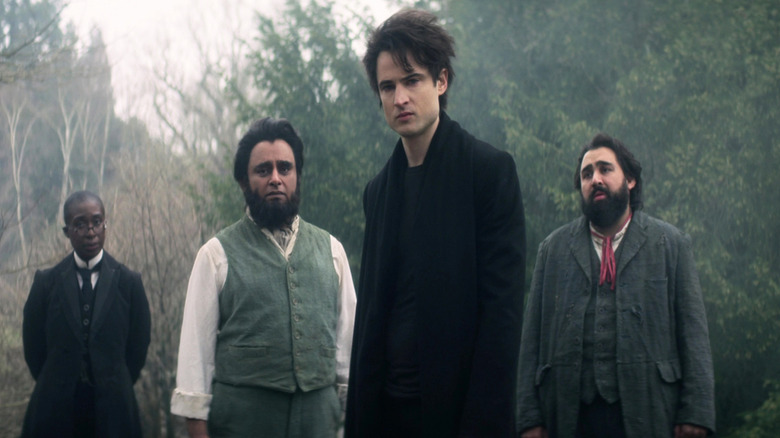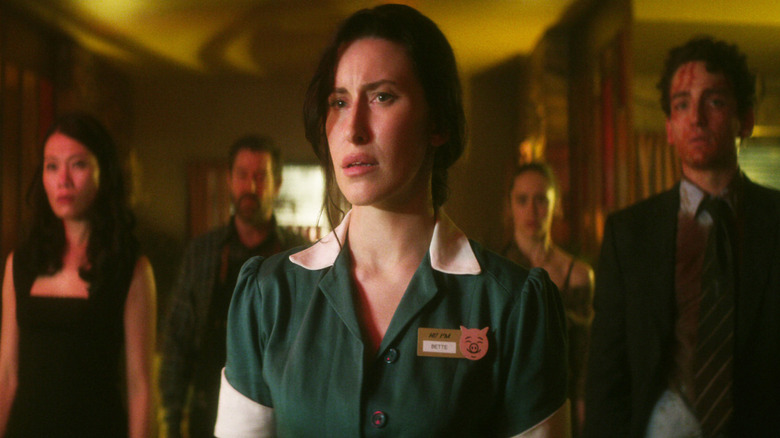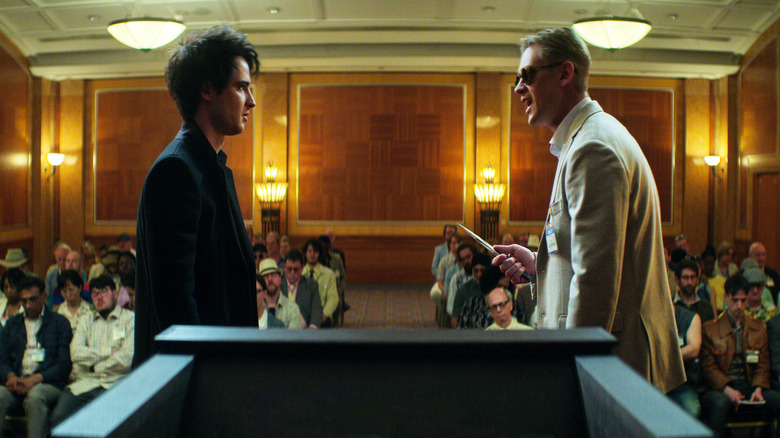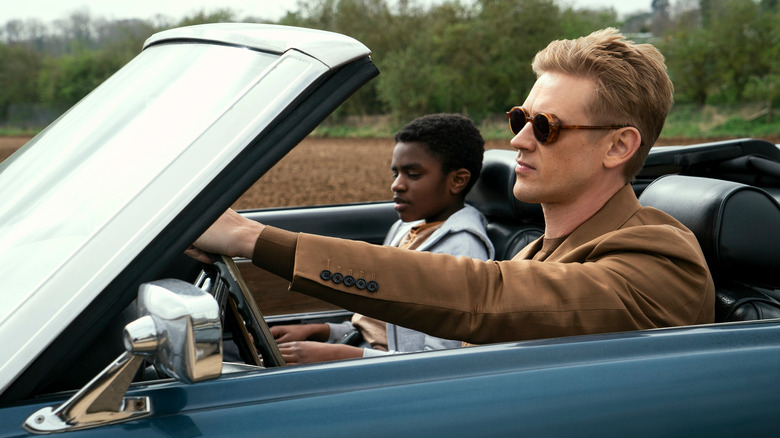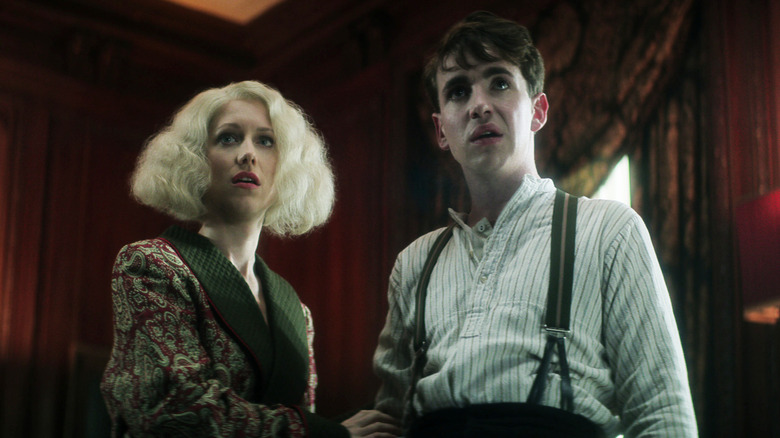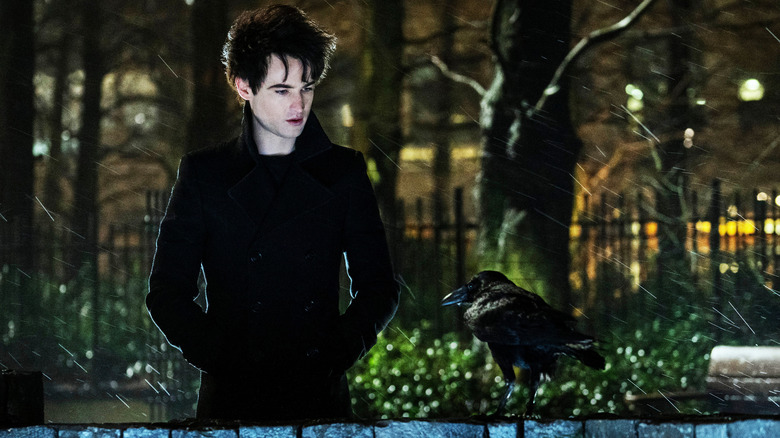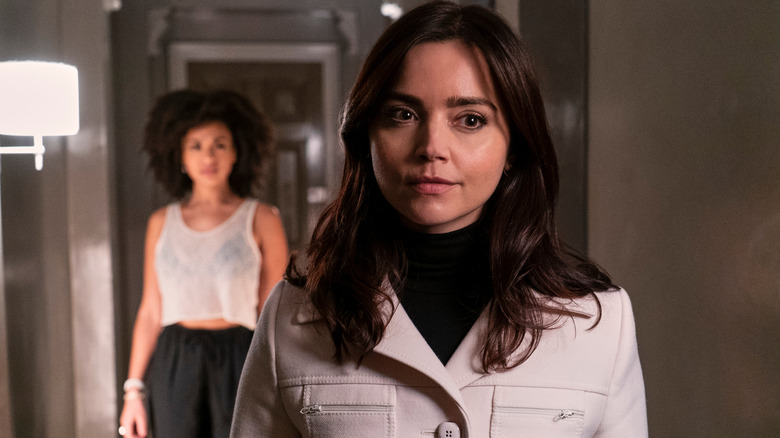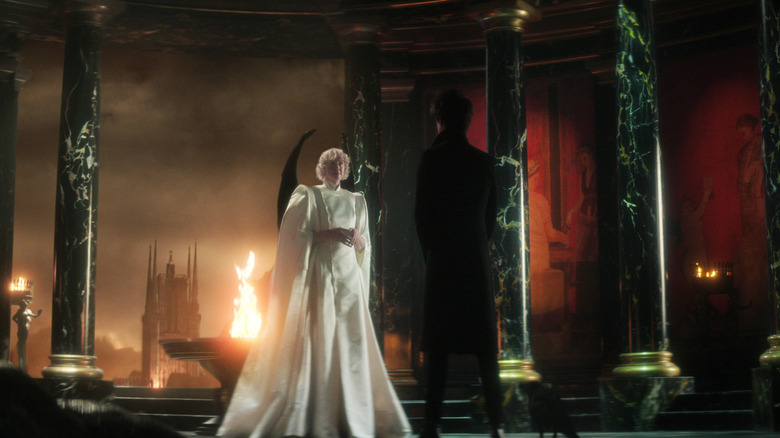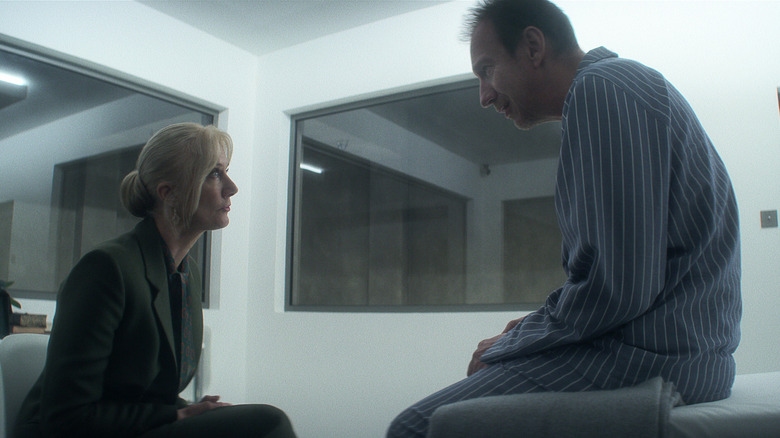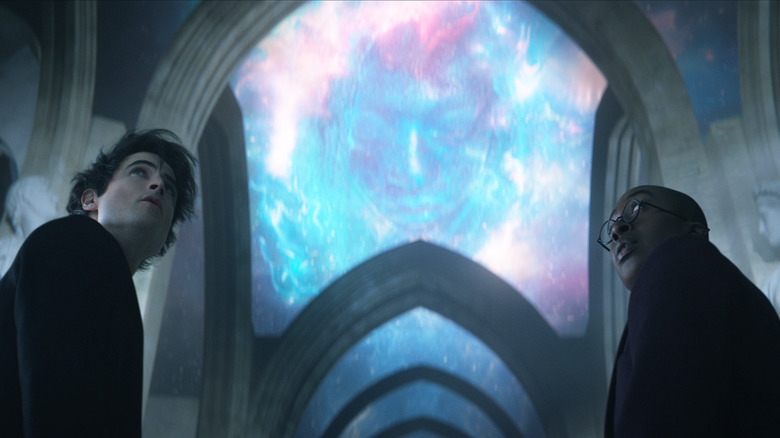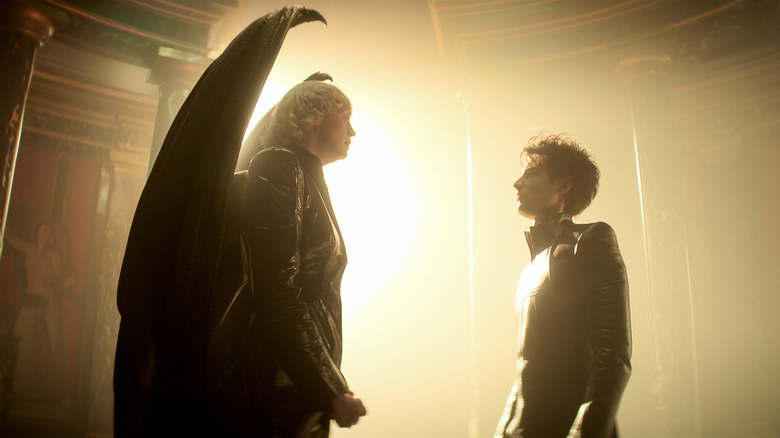The Biggest Issues With Netflix's The Sandman
When readers meet Dream in "The Sandman" comic series, he's a traumatized, wrathful, and sad-sack mythical being who sees no issue in doling out eternally harsh punishments. If the dreams and nightmares that he brought into existence disappoint him, our Robert Smith lookalike often "uncreates" (read: kills) them. (Truly, the worst parent ever.) Neil Gaiman's writing revolves around how Dream, an Endless being fated to exist until existence is no more and serve humanity, resents his purpose. Dream's dour outlook, directly and indirectly, causes a lot of painful misery for others, which eventually causes him to change his tune. Due to this character arc, the series' first two volumes are extremely dark. There is no shortage of body horror, uncanny nightmares, serial killers, and sexual assault.
Ironically, Death, his sister, is the character who inspires hope in him and in the series' discussion about life's ephemeral nature. Since Netflix's "The Sandman" aimed to capture Gaiman's world in "Preludes & Nocturnes" and "The Doll's House," it was an open question as to how the adaptation would embrace the run's horror roots. While "The Sandman" television series neatly streamlines Gaiman's sprawling story, the show focuses more on fantasy-action than horror, toning down key characters' physicality, nightmares, grotesque background details, and omitting set-pieces. Instead, the Netflix series dials up its dread through character interactions while splashing in gore during action-led moments. Although this approach works, for the most part, the balance still feels a bit off.
If you or anyone you know has been a victim of sexual assault, help is available. Visit the Rape, Abuse & Incest National Network website or contact RAINN's National Helpline at 1-800-656-HOPE (4673).
24/7 episode teases the horror that could have been
If you're reading this, you're likely already asking, "But what about episode '24/7'?" Yes, this one episode veers the most successfully into horror than the rest of the season. In the comics, this scene is intense, to put it mildly. Overall, Netflix's "The Sandman" highlighted its never-ending brutal moments well. Its dialogue brings in more horrifying character reveals, upping the tension. Viewers harrowingly hear a chopping sound before seeing severed fingers on a cutting board. The show even (surprisingly) showed the moment when a character stabs their eyes out. It feels like Jonathan wants to destroy the world and the diner is his training ground.
However, the camera feels shy about the carnage it's depicting. Shots pan around the direct violence happening and sweeps over the diner's dead bodies. Even the eye-gouge moment happens in a flash. It's as if the camera wants the viewer to look at the violence but not too long. Sadly, that quick pacing undercuts the emotional impact of the kills. The gore is important to show here as it demonstrates how much power Dream's ruby has and how inconsequential people are around that much power. It lends some insight into why Dream feels so distanced from humans — as it'd take little of his power to kill them if tempers flare. "24/7" teases how touches of horror could elevate the show's approach to showing the best and worst of humanity and how that affects Dream's perspective.
Why Corinthian as a Big Bad doesn't work
Netflix's "The Sandman" had the unenviable task of adapting almost 500 pages worth of comic panels. Even with a 10-episode season, with each episode being one hour long, that's still a lot of ground for a show to cover. Cleverly, the television series streamlined a lot of the story by cutting out ancillary DC characters — like the Justice League of America and Hell's fellow rulers Brute and Glob. But one of the show's major changes from the comic inadvertently undercuts the comic series' central question: Is mankind good or evil?
In the comics, Dream is captured by Roderick Burgess and his cult by accident. They meant to capture Death but once they realize they have Dream, they hold him hostage for over 100 years, thinking he'll eventually break and give them access to immortality. People die and succumb to sleeping sicknesses. Burgess knows about the Endless and metaphorically proves that humanity will endanger the entire world in exchange for power. In the Netflix series, The Corinthian educates Burgess on Dream's identity. He continues to be Season 1's Big Bad, orchestrating events to keep Dream captive and interacting with characters he never met in the comics. This not only weakens Burgess' storyline but also makes the nightmare seem less threatening, too. In the comics, The Corinthian is an unhinged and conventionally attractive serial killer, preying on young men. Having him be methodical instead of unpredictable lessens his mercurial terror.
The Corinthian's look sacrifices his terror
In "The Sandman" comics, The Corinthian doesn't appear until its second volume, "The Doll's House." He's blonde, wearing tight jeans, white cut-off shirts, and dark sunglasses — to hide his eye sockets full of teeth. He hunts young men, bringing to mind the likes of a Ted Bundy-type hustler. At one point in the run, Rose sees him from afar and calls him "cute," a moment that's terrifying for readers because his attractiveness makes him even more of a powerful nightmare. Like in real life, people can be drawn to a killer because of their good looks.
But the Netflix series gives The Corinthian a slight makeover that doesn't quite work. He has a '90s-era Tim Robbins-like look mixed with a southern gentleman vibe. He's more detached and less sexually objectified than the nightmare shown in comics, which loses sight of the comics' focus on the real-life terror of weaponized beauty. When he collects eyeballs in the comics, there's a clear fetishism attached to it. There's a hunger there for that act that readers see on the page through his glee to seduce others for his appetite, which makes his later Cereal Convention speech hit hard. But the show tamps down on delving into this grotesque carnality of The Corinthian, which lessens his potential to be more of an original villain.
Eternal waking vs. eternal sleeping
One minor change in Netflix's "The Sandman" adaptation robs the story of showing just how brutal Dream can be. In the comic run, Dream cursed Alex with eternal waking to make him live in nightmares for the rest of his life. Each time Alex thinks he's woken up and the dreaded dream is over, another terror begins. The sheer prospect of hope makes the punishment devastating to watch. Also, it highlights grotesque imagery like faces melting off. In the Netflix series, Alex is stuck in a nightmare but never wakes up. While it's certainly a horrific fate for Alex, it feels less daunting than the comic's punishment as he's not teased with the idea that he finally escaped Dream's punishment time and time again.
The brutality shown by Dream in the comic run isn't just to be gratuitous. "The Sandman" comic covers heavy questions like: Is humanity worth saving? Initially, Dream is unconvinced that everyone is and it's through his journey — and connection to Rose Walker — that he learns to reconnect with humanity and becomes more humane in the process. By the end of "The Sandman" tale, readers feel uplifted with the belief in potential, specifically that they have the power to recreate themselves and the world's flawed systems. To land that mark, readers need to see a direct change in how Dream becomes less severe over time.
Dream's look and demeanor is toned down too much
Despite Dream being imprisoned for 100 or so years, he looks very clean-cut in Netflix's "The Sandman." While Tom Sturridge nailed the physicality of Dream — with his taut and lanky frame that towers over others — there's an edginess to Dream that's missing. Especially in the comic's earlier issues, Dream feels more sinister and shadowy on the page. Sure, sometimes he has stars in his eyes, but those eyes can also turn as dark as the night. It's surprising that the show's special effects didn't play more with Dream's eyes turning black, a small effect that would have unnerved viewers.
Neil Gaiman based Morpheus' design on '80s-era Bauhaus' Peter Murphy, and this darker punk-rock feel 100 percent comes across on the page. It's not explicitly stated, but the artwork renders a Dream who looks like he owns a lot of eyeliner and hair gel (though it's less likely he washed his hair that day). Artist Mike Dringenberg drew Dream's hair a bit raggedy and poofy in a way that can't not remind certain readers of Robert Smith, especially during Dream's moodier moments. Overall, this look works because it defines the contradiction that is Dream: he's a creature that feels misunderstood and outside of society. Dream could kill anyone on a whim or grant them an artful dream. Toning down his demeanor so early in the series lessens the creative potential to show Dream's character growth through his hair, makeup, and clothing choices.
Omitting horror set pieces
Overall, Netflix's "The Sandman" feels like it purposefully toned down its horrifying moments to appeal to a younger audience. When this is done to better serve the story, it works. Giving characters like Rose Walker more agency and omitting the series' over-reliance on rape as a premise for several characters' story arcs are clever moves. But other times, it seems like horror set pieces were removed to make it less terrifying for viewers. The main one that comes to mind is how Netflix's "The Sandman" changed Rachel's storyline.
In the comics, Rachel has a substance abuse problem and becomes addicted to sand. Her actions trap her in her apartment as the dreams eat away at reality — quite literally — and turn her father into a wall of flesh. In the Netflix series, Johanna Constantine gives the sand to Rachel to hold onto, unintentionally dooming her. However, Rachel's apartment isn't torn apart by dreams. It looks normal. Deciding to make Rachel's tragic fate Constantine's fault was a compelling change as it lends more emotional depth to the latter's journey. But making Rachel's home tidier (visually) weakens the terror of Dream's sand. There was room for both drama and the sinister stakes of sand so that viewers believe Dream is dangerous, too.
If you or anyone you know has been a victim of sexual assault, help is available. Visit the Rape, Abuse & Incest National Network website or contact RAINN's National Helpline at 1-800-656-HOPE (4673).
If you or anyone you know is struggling with addiction issues, help is available. Visit the Substance Abuse and Mental Health Services Administration website or contact SAMHSA's National Helpline at 1-800-662-HELP (4357).
Hell lacks monsters
The Hell viewers see in Netflix's "The Sandman" looks gorgeously ornate. There are marble columns and pits of fire, and it's a welcomed change to see a flashier version of Lucifer's palace. However, the rest of Hell seems masked in CGI smoke and torches. Aside from Mazikeen, who looks terrifyingly fantastic, there aren't many demons shown. Instead, there are only glimpses into a crowd of faceless monsters that are hard to individually see. Viewers only see Hell's inhabitants from a distance, missing out on a chance to show how diverse these demons are. Sadly, it makes them and Hell's scenes unremarkable.
Obviously, it's easier to craft as wily a demon crowd as possible in comics. Panels don't have the same budget restrictions as television productions do. With a reported budget of nearly $15 million per episode, though, the series could have afforded to spice up Hell's demons. Despite budget constraints, the show could have used practical effects to bring a handful of monsters to the forefront, adding a palpable sense of danger to Dream's journey. Without fearing what could happen to Dream, it's a lot harder to buy into what does over the course of 10-hour-long episodes. The show underestimates the power and necessity of fear.
Jonathan's appearance and state of mind
First thing first, David Thewlis delivers an unsettling portrayal of Jonathan, aka Doctor Destiny. The choice to make Jonathan's sinister side come out slowly with a mumbling tone is inventive, adding an enjoyable layer to the adage "beware of the quiet ones." But the downside to this style of Jonathan is that it gives the formidable Thewlis less of a range to play the villain on-screen and lacks the interesting contrast that the comic version of him has.
In "The Sandman" comics, Jonathan is entirely unhinged to the point that he makes DC's Scarecrow look mentally stable. However, he's relatively soft-spoken, which comes across as more jarring since his appearance is more like a melting skeleton than a man. The choice to embrace a softer-spoken villain on-screen would have worked even better if his look leaned more on the side of terror. Narratively, it also lands well because there's visual evidence that Jonathan's use of the ruby has decayed his mind and soul. Seeing a version of that on-screen, even if it was just his decaying hands that he hides from others, would give more character development to play with — especially in episode "24/7."
Lack of spending time in other people's dreams
Sometimes, Netflix's "The Sandman" feels as if it's using so many special effects just because it can. Some of its most interesting moments are when the scenes utilize real sets and real people and contrast them in a way that's purposefully jarring. That's also what made "The Sandman" comics work, having insight into the ordinary amidst the extraordinary. A great example of this is when the television show gives viewers a glimpse of Chantal's dream. Rose walks into Chantal's dream at the moment when she's reciting her "relationship to a sentence" to a room full of people the viewer has never seen before. Like Rose, it's jarring because it feels so real. There are a handful of dream segments that play out across the series that works well, especially Jed's superhero battles. However, the show steers away from delving into individual nightmares that lessens not just the vastness of The Dreaming but also Rose Walker's understanding of humanity.
In "The Sandman" comics, there are several nightmare sequences. One of the best ones is when Rose stumbles into her neighbors' dreams, accidentally glimpsing not just their joys but their fears. Visually, it's exciting, alarming, and overwhelming — all things that Rose is feeling. Unfortunately, the darker side of ordinary people isn't shown much in the series. Instead of using nightmares to show the complexity of people, it relies on its serial killers' dreams to do the work.
Camera angles don't take enough creative risks
A huge part of what made "The Sandman" such a successful piece of art is because it took risks playing with panel layouts; flipping perspectives, diagonally merging panels, and utilizing full splash pages to highlight key moments. Not unlike a camera angle, these layout moves drove the run's pacing, emotional beats, and point-of-view. One of the run's coolest panel moves is when Rose Walker is dreaming in the back of the car. Since she's lying down, the entire panel layout turns on its side, just like she is sleeping. Rose's dreams then play out vertically as people's conversations in the car play out horizontally.
However, the show is surprisingly bland in how it sets up camera angles, missing out on the chance to do things like utilizing drone shots to establish an expansive feeling when viewers are in the infinite world of The Dreaming. When Rose walks through dreams, it's just her walking. There's no sense of scale to it, which feels strange since it limits creative ways to visualize how big dreams or dreamers are and how much access Rose is able to have. This careful feeling echoes even harder when Rose encounters nightmares. Again, it's harder to root for a journey that feels too safe. While "The Sandman" excels as a fantasy action drama, it could have struck more horror notes throughout to raise the show's stakes, tension, and make its heartwarming moments feel even more welcomed.
